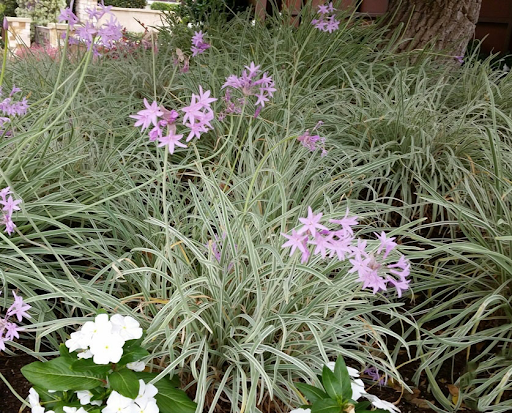What is a pollinator and why are they important?
We see them every day in our backyards. A pollinator can be an animal or insect. For example birds, bees, and butterflies are all known as pollinators. Different species of pollinators are important to various species of plants. The pollinator gathers pollen grains from the anther of a male flower and transfers it to the stigma of a female flower, and once fertilized, the flower will produce seeds. Pollination is so vital, not just because it produces new flowering plants and generates the fruits we eat, it's also essential for biodiversity and thriving ecosystems. Imagine if a few or even one flower or plant was the main food source for a certain species. Without pollination, those plants the species depend on could vanish. Which would potentially throw off the balance of the whole ecosystem. Pollinators might seem inconsequential to the everyday person, but in reality, they are invaluable and irreplaceable, because without them the earth would be uninhabitable for all.
Types Pollinators in our own Backyard
Bees
It’s quite astonishing that there are over 1,000 species of California native bees. Every single species has their own preference for plants and unique ways of transferring pollen. For example, the Digger Bee (Anthophora) has the ability to pollinate deep and tubular blossoms by burrowing deep into flowers resulting in their whole top half becoming covered in pollen grains. This is good news for wildflower diversity and vital for some endangered plant species. Another species called the Metallic Leafcutter Bee spreads pollen by cutting leaves off plants, not just to feed on, but to use for nesting cells. Bees are amazing pollinators because they gravitate to specific flowers, which helps maintain order and makes sure all flowers in their area get pollinated. Another reason they're great pollinators is that their fuzzy bodies act as a pocket, where vast amounts of pollen can be stored.
Megachile spp. (Gold Tipped Leaf Cutter Bee)
Anthrophorini spp. (Digger Bee)
Apis mellifera (European Honey Bee)
Butterflies
Not only are they beautiful to look at and admire, they are an indicator of a healthy ecosystem. Unfortunately the opposite is also true. As butterfly populations decrease it could indicate negative changes occurring in the environment. These unwanted changes could be a culmination of pesticide/insecticide use in the area, increase in pollution, loss of habitat, or extreme drought. Currently, the Western Monarch Butterfly population in California is experiencing a devastating decrease, with an 86% reduction, from a total of 148,000 butterflies in 2017 to just 20,456 by the end of 2018. Today the population is still hovering around 20,000. If the species does go extinct, there may be unforeseen detrimental effects, because they act as pollinators and are a food source for some predators. This just goes to show how sensitive and connected butterflies are to changes in the environment and that a decline in butterfly populations should be taken seriously.
Butterflies have little to no drawbacks, as they feed on the nectar of plants and only a few species cause minor damage to commercial plants. In Santa Clara County alone, 190 species of butterflies have been identified [butterfliesandmoths.org]. Worldwide, there are around 24,000 species of butterflies. Just like bees, butterflies carry pollen on their bodies with nectar being their main food source. Additionally, butterflies naturally prefer wildflowers with stronger scents. Although some species do feed on plants, there are species of butterflies that act as natural pest control, for example the Harvester Butterfly, which feeds on aphids during its larval stage.
Adelpha californica (California Sister Butterfly)
Battus philenor (Pollen shown on wings of Pipevine Swallowtail Butterfly)
Moths
While the order Lepidoptera includes all moth and butterfly species (140,000), moths take over pollination duties during the night, although some species also pollinate during the day. Moths mainly go for flowers that bloom at night and are full of nectar, and this under-appreciated pollinator helps diverse ecosystems thrive. However, many moth species are also facing a daunting future. As human populations are rapidly growing, so are cities that are becoming quickly overpopulated, and one side effect of this urban growth is light pollution. Lights from buildings, street lights, homes, cars, and any artificial light source contributes to light pollution. Unfortunately, moths are attracted to a type of wavelength light bulbs emit, which disrupts their natural habits during the night. As a pollinator, any disruption in their region can have adverse effects on the population. One study, done in the UK by Butterfly Conservation, says the overall number of moths have declined by 28%, with certain endangered species, such as the Garden Tiger, experiencing a drastic decline of 92%. Over the past decades, 60 other species once common are now extinct in the UK. The good news is studies have shown that moths are visiting plants and crops that were previously only known to be visited by bees and butterflies, and actually complement the work of bees, which shows just how integral moths are to ecosystems. Moths are also beneficial to commercial crops and agriculture, as they can carry pollen over great distances.
Cisseps fulvicolliss (Yellow Collared Scape Moth)
Sphinx ligustri (example of the Privet Hawk Moth having tongues double the length of body)
Flies
These little pollinators, along with gnats and mosquitos, form a very large proportion of pollinators. These two-winged pollinators may not be as effective in carrying pollen from flower to flower, as flies don’t have that attractive furry coat bees or even butterflies have, but flies make themselves extremely useful by going after the plants that other pollinators find less aromatically pleasant. For example, flies love to feed on the pollen of the flower Red Trillium (Trillium erectum), because the shade of red on the flower resembles the color of meat and the odor it produces is similar to decaying carrion. Plant species that produce putrid-smelling odors or have pale dark colors, but otherwise are aesthetically pleasing, have a lot to thank for the small yet significant fly pollinators.
Lucilia sericata (Green Bottle Fly)
Trillium erectum (Red Trillium)
Birds
Bird pollination, also known as Ornithophily, is pollination of certain species of flowers by birds. There are around 2,000 bird species that feed on nectar. The birds, in this case, are known as nectarivorous birds that rely heavily on nectar for their diet and have physical features to allow them easy access to nectar from flowers. Examples of nectarivorous birds are the various species of hummingbirds, sunbirds, and honeyeaters. The flowering plants that rely on ornithophily have traits that cater to nectarivorous birds, and these flowers are usually brightly colored, hold a great amount of nectar, and are mostly odorless. These species of flowers also are structured in a way that benefits birds that hover or perch. Take for example the Bignonia capreolata, also known as the Trumpet Flower, these flowers are loaded with nectar and the shape of the flower is accessible for hovering hummingbirds. Since some of these nectarivorous birds and flowers have coevolved for generations, it's clear that if a species of nectarivorous bird goes extinct then it's possible the flower that it coevolved with will face the same fate. But it’s amazing that some of the smallest bird species can have such a large impact as pollinators. Just in the United States, these nectarivorous birds are responsible for the continuous fertilization of many wildflower species.
Hovering bird, Selasphorus platycercus (Broad-tailed Hummingbird), pollinating Lonicera sempervirens (Coral Honeysuckle)
Perched bird pollinating Corymbia ficifolia (Red Flowering Gum)
(Bignonia capreolata, Trumpet Flower)
How to help pollinators
Plant Natives: By planting a diverse garden of native plants you will create a bountiful habitat of pollen and nectar that pollinators will naturally be enticed to.
Avoid Pesticides: Insecticides and herbicides are chemicals that don’t belong in our ecosystems or even in our yards. Pesticides harm beneficial plants and insects.
Volunteer: Join an environmental program that teaches people about pollinators, learn what plants are native to your area, and connect with other environmentalists to see how you can further help in your community.
Support Land Conservation: Pollinators and native plants deverse a habitat nurtured for them. Help to maintain or create pollinator gardens in your community and watch pollinators in your area thrive.
Citations
“Agents for Pollination: Anemophily, Zoophily and Hydrophily (With Diagrams).” Biology Discussion, 16 Oct. 2015, www.biologydiscussion.com/pollination/agents-for-pollination-anemophily-zoophily-and-hydrophily-with-diagrams/13503.
Ames, Hayley. “Why Are Butterflies Important?” Sciencing, 13 Aug. 2019, sciencing.com/butterflies-important-8749269.html.
“Butterflies of California.” INaturalist, www.inaturalist.org/check_lists/10675-Butterflies-of-California.
“California Insects (552 Found).” Insect Identification, www.insectidentification.org/insects-by-state.asp?thisState=California.
Criss, Doug. “The Monarch Butterfly Population in California Has Plummeted 86% in One Year.” CNN, Cable News Network, 7 Jan. 2019, www.cnn.com/2019/01/07/us/monarch-butterflies-decline-trnd/index.html.
Deng, Boer. “These Flowers Have an Ingenious Pollination Mechanism.” Slate Magazine, Slate, 16 July 2014, slate.com/technology/2014/07/birds-pollinating-flowers-bellows-mechanism-blows-pollen-from-stamen-onto-beaks.html.
“Endangered Hummingbirds List.” Home, www.hummingbirdsociety.org/endangered-hummingbirds-list.
MacGregor, Callum J, et al. “Pollination by Nocturnal Lepidoptera, and the Effects of Light Pollution: a Review.” Ecological Entomology, Blackwell Publishing Ltd, June 2015, www.ncbi.nlm.nih.gov/pmc/articles/PMC4405039/.
“Natural Resources Conservation Service.” NRCS, www.nrcs.usda.gov/wps/portal/nrcs/main/national/plantsanimals/pollinate/gardeners/.
“Ten Tips to Help Pollinators.” KidsGardening, 1 June 2017, kidsgardening.org/ten-tips-to-help-pollinators/.
“The Nocturnal Pollinators: Scientists Reveal the Secret Life of Moths.” Home Page, butterfly-conservation.org/news-and-blog/the-nocturnal-pollinators-scientists-reveal-the-secret-life-of-moths.
“U.S. Forest Service.” Forest Service Shield, www.fs.fed.us/wildflowers/pollinators/animals/moths.shtml.
“U.S. Forest Service.” Forest Service Shield, www.fs.fed.us/wildflowers/pollinators/animals/flies.shtml.
“U.S. Forest Service.” Forest Service Shield, www.fs.fed.us/wildflowers/pollinators/animals/birds.shtml.






























